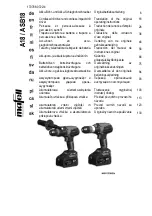
k)
Hold power tool by insulated gripping
surfaces only, when performing an oper-
ation where the cutting accessory may
contact hidden wiring or its own cord.
Cutting accessory contacting a “live” wire
may make exposed metal parts of the
power tool “live” and could give the operator
an electric shock.
l)
always hold the tool firmly in your
hand(s) during the start-up.
The reaction
torque of the motor, as it accelerates to full
speed, can cause the tool to twist.
m)
use clamps to support workpiece when-
ever practical. never hold a small work-
piece in one hand and the tool in the
other hand while in use.
Clamping a small
workpiece allows you to use your hand(s)
to control the tool. Round material such as
dowel rods, pipes or tubing have a ten-
dency to roll while being cut, and may
cause the bit to bind or jump toward you.
n)
Position the cord clear of the spinning
accessory.
If you lose control, the cord
may be cut or snagged and your hand or
arm may be pulled into the spinning acces-
sory.
o)
never lay the power tool down until the
accessory has come to a complete stop.
The spinning accessory may grab the sur-
face and pull the power tool out of your con-
trol.
p)
after changing the bits or making any
adjustments, make sure the collet nut,
chuck or any other adjustment devices
are securely tightened.
Loose adjustment
devices can unexpectedly shift, causing
loss of control, loose rotating components
will be violently thrown.
q)
Do not run the power tool while carrying
it at your side.
Accidental contact with the
spinning accessory could snag your cloth-
ing, pulling the accessory into your body.
r)
regularly clean the power tool’s air
vents.
The motor’s fan will draw the dust in-
side the housing and excessive accumula-
tion of powdered metal may cause electrical
hazards.
s)
Do not operate the power tool near flam-
mable materials.
Sparks could ignite these
materials.
t)
Do not use accessories that require liq-
uid coolants.
Using water or other liquid
coolants may result in electrocution or
shock.
Further safety instructions for all op-
erations
Kickback and related warnings
Kickback is a sudden reaction to a pinched or
snagged rotating wheel, sanding band, brush
or any other accessory. Pinching or snagging
causes rapid stalling of the rotating accessory
which in turn causes the uncontrolled power
tool to be forced in the direction opposite of the
accessory’s rotation.
For example, if an abrasive wheel is snagged
or pinched by the workpiece, the edge of the
wheel that is entering into the pinch point can
dig into the surface of the material causing the
wheel to climb out or kick out. The wheel may
either jump toward or away from the operator,
depending on direction of the wheel’s move-
ment at the point of pinching. Abrasive wheels
may also break under these conditions.
Kickback is the result of power tool misuse
and/or incorrect operating procedures or con-
ditions and can be avoided by taking proper
precautions as given below.
a)
Maintain a firm grip on the power tool
and position your body and arm to allow
you to resist kickback forces.
The opera-
tor can control kickback forces, if proper
precautions are taken.
b)
use special care when working corners,
sharp edges etc. avoid bouncing and
snagging the accessory.
Corners, sharp
edges or bouncing have a tendency to snag
- 12 -













































